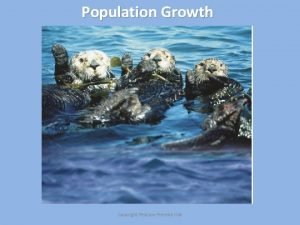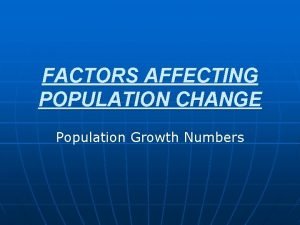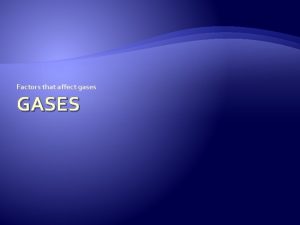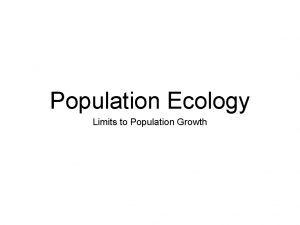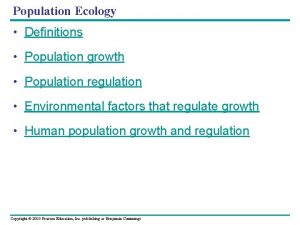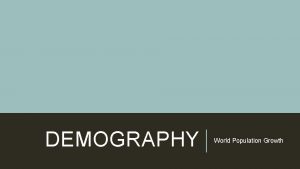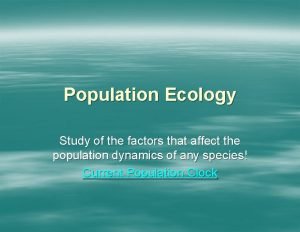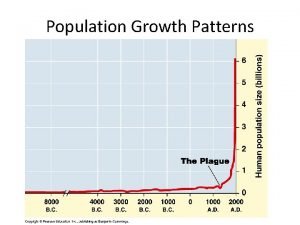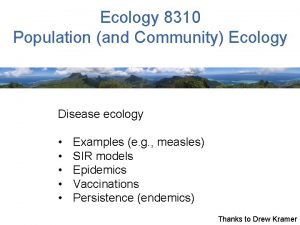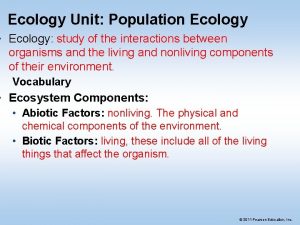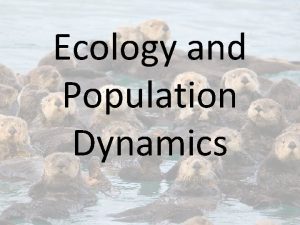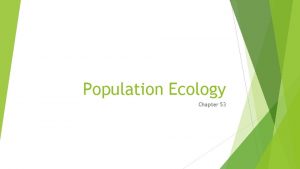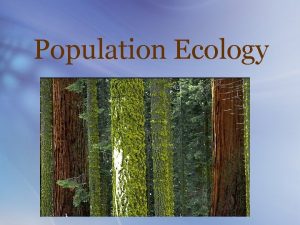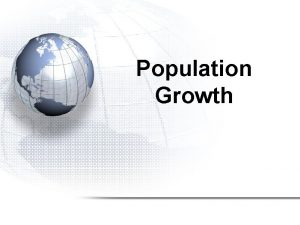Population Ecology What Factors Affect Population Growth Millions



















- Slides: 19

Population Ecology

What Factors Affect Population Growth? • Millions of red crabs live in Christmas Island in the Indian Ocean. Each year, the entire adult crab population migrates from forest to sea to breed, making daily life a bit tricky for human residents! What factors could influence the growth or decline of the red crab’s population size?

Penguins! • What factors could affect the size of penguin populations in Antarctica? • http: //video. nationalgeographic. com/video/ kids/animals-pets-kids/birds-kids/penguinemperor-parenting-kids/ • http: //dsc. discovery. com/tv-shows/frozenplanet/videos/criminal-penguin. htm

How do Ecologists Study Populations? • Geographic Range=the area inhabited by a population. • A population’s range can vary enormously in size, depending on the species. North Carolina Black Bear Population Range: 1971—About 4, 000 bears occupied approximately 2. 5 million acres 2008—About 11, 000 bears lived on almost 10 million acres

How do Ecologists Study Populations? Population Density=number of individuals per unit area. • Populations of different species often have very different densities, even in the same environment.

Population Distribution • Population Distribution=how individuals in a population are spaced out.

What type of Population Distribution is seen in Penguins?

Population Growth Rates • Population Growth=Birth Rate-Death Rate • A population’s growth rate determines whether the size of the population increases, decreases or stays the same. • Hydrilla populations tend to stay the same size over time in its native range in Indonesia. • The Hydrilla population in Florida, by contrast, has a high growth rate. What factors are influencing The growth rate of Hydrilla?

Population Growth-Migration Births + Immigration = • Immigration vs. Population ↑ Emigration • A population may grow if individuals move into its range (Immigration). • A population may decrease if individuals move out of its range (Emigration). Deaths + Emigration = Population ↓

Exponential Growth • If you provide a population with all the food and space it needs, protect it from predators and disease, and remove its waste products, what will happen? How many bacteria will there be in 6 more days? (1. 0 X 1013) That is 10, 000, 000!

Exponential Growth The size of each generation is larger than the generation before it. The larger a population gets, the faster it grows! This is called exponential growth. In ideal conditions, all species will exhibit exponential growth, resulting in a J-shaped growth curve.

Logistic Growth • Natural populations don’t grow exponentially for long. Sooner or later, something stops exponential growth. • • Phase 1: Exponential growth Phase 2: Growth slows down Phase 3: Growth stops This produces an “S-shaped” curve • (NOTE: This does not mean the species dies out— only that the growth of the population stops. )

Carrying Capacity • When the birth rate and death rate are the same and when immigration equals emigration, population growth stops. • It may still rise and fall somewhat, but the ups and downs average out at its’ carrying capacity. • Carrying Capacity is the maximum number of individuals that a particular environment can support for an extended period of time. What is the carrying capacity of deer on Walla Island?

Limiting Factors • A limiting factor is a factor that limits the growth of a population. They determine the carrying capacity of an environment for a particular species. These may include: • • • Competition Predation Parasitism & Disease Natural disasters Severe weather

Density-Dependent Limiting Factors • Density-dependent Limiting Factors operate strongly only when the population density reaches a certain level. • These include: • Competition • Predation and Herbivory • Parasitism • Disease • Stress from overcrowding The relationship between Lynx and Snowshoe hare illustrates how predation can affect population growth.

Density-Independent Growth Factors • Density-Independent Limiting Factors affect all populations—no matter how big or small they are. • These include: • Severe weather events such as hurricanes or drought • Floods • Wildfires • Natural disasters

What would be limiting factors for Emperor Penguins? • What factors would influence the size of Emperor Penguin populations?

Keystone Species • Sometimes changes in the population of a single species, called a keystone species can cause dramatic changes in the structure of a community. Sea otters are a keystone species on the northern California coastlines and their favorite food is sea urchins. Sea urchins are herbivores whose favorite food is kelp, giant algae that grow in undersea “forests”. Sea otters were nearly eliminated due to hunting. When that happened, however, sea urchin populations skyrocketed and they ate all the kelp. Without kelp to provide habitat, many other animals disappeared. When otters became protected, the ecosystem slowly recovered.

Organisms in Antarctica • Which of the following is the keystone species of Antarctica? Krill Skua Chinstrap Penguin Adelie Penguin Leopard Seal Emperor Penguin
 The concept of population
The concept of population Chapter 4 section 1 population dynamics answer key
Chapter 4 section 1 population dynamics answer key Section 1 population dynamics
Section 1 population dynamics Population ecology section 1 population dynamics
Population ecology section 1 population dynamics Chapter 4 section 1 population dynamics
Chapter 4 section 1 population dynamics Europe population in millions
Europe population in millions Population growth factors
Population growth factors Population growth factors
Population growth factors Population ecology example
Population ecology example K selection r selection
K selection r selection Is india near the equator
Is india near the equator Ecosystem vs community
Ecosystem vs community Concept 3 population ecology
Concept 3 population ecology Chapter 53 population ecology
Chapter 53 population ecology Equilibrial life history
Equilibrial life history Ecology
Ecology Lynx and hare relationship
Lynx and hare relationship Chapter 53 population ecology
Chapter 53 population ecology What is uniform dispersion
What is uniform dispersion Chapter 4 section 1 population dynamics answer key
Chapter 4 section 1 population dynamics answer key






